1.CPtrArray指针数组
2.CPtrArray返回void指针,需要做类型转换
3.View类中的OnPaint调用OnPrepareDC和OnDraw,如果覆盖OnPaint,就不会调用OnDraw(除非显式调用)
4.坐标空间
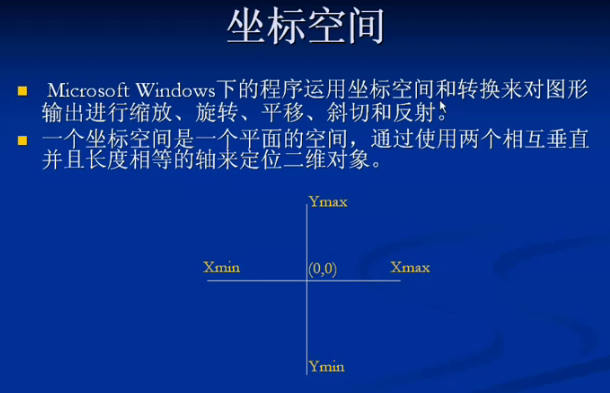
Coordinate Spaces and Transformations
Win32®-based applications use coordinate spaces and transformations to scale, rotate, translate, shear, and reflect graphics output. A coordinate space is a planar space that locates two-dimensional objects by using two reference axes that are perpendicular to each other. There are four coordinate spaces: world, page, device, and physical device (client area, desktop, or page of printer paper).
A transformation is an algorithm that alters ("transforms") the size, orientation, and shape of objects. Transformations also transfer a graphics object from one coordinate space to another. Ultimately, the object appears on the physical device, which is usually a screen or printer.
About Coordinate Spaces and Transformations
Coordinate spaces and transformations are used by the following types of applications:
Desktop publishing applications (to "zoom" parts of a page or to display adjacent pages in a window).
Computer-aided design (CAD) applications (to rotate objects, scale drawings, or create perspective views).
Spreadsheet applications (to move and size graphs).
The following illustrations show successive views of an object created in a drawing application. The first illustration shows the object as it appears in the original drawing; the succeeding five illustrations show the effects of applying various transformations.
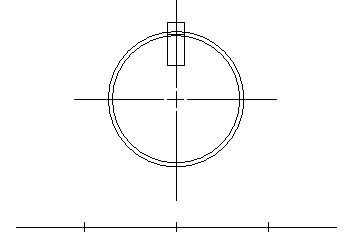


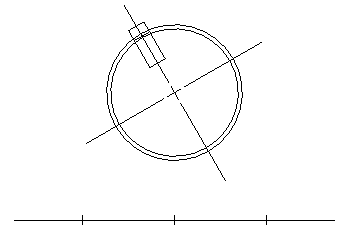
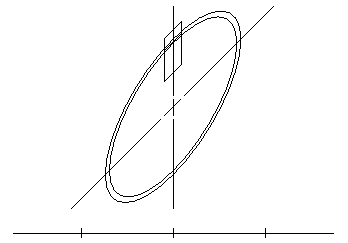

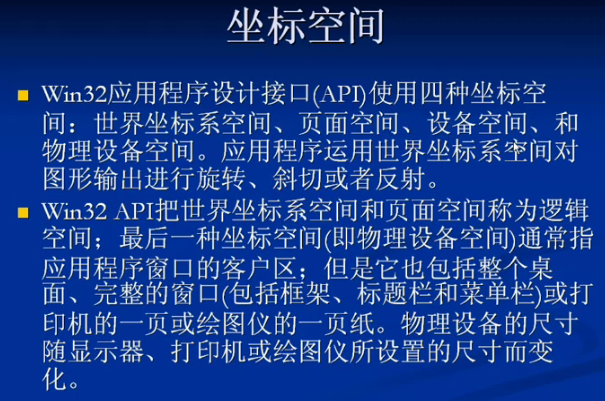
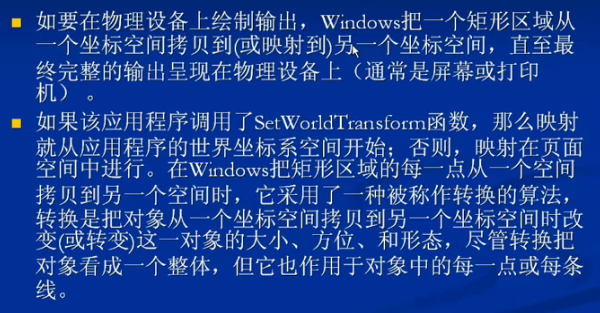

Using Coordinate Spaces and Transformations
This section contains an example that demonstrates the following tasks:
Drawing graphics with predefined units.
Centering graphics in the application's client area.
Scaling graphics output to half its original size.
Translating graphics output 3/4 of an inch to the right.
Rotating graphics 30 degrees.
Shearing graphics output along the x-axis.
Reflecting graphics output about an imaginary horizontal axis drawn through its midpoint.
The following example was used to create the illustrations that appear earlier in this overview.
void TransformAndDraw(int iTransform, HWND hWnd)
{
HDC hDC;
XFORM xForm;
RECT rect;
// Retrieve a DC handle for the application's window.
hDC = GetDC(hWnd);
// Set the mapping mode to LOENGLISH. This moves the
// client area origin from the upper left corner of the
// window to the lower left corner (this also reorients
// the y-axis so that drawing operations occur in a true
// Cartesian space). It guarantees portability so that
// the object drawn retains its dimensions on any display.
SetGraphicsMode(hDC, GM_ADVANCED);
SetMapMode(hDC, MM_LOENGLISH);
// Set the appropriate world transformation (based on the
// user's menu selection).
switch (iTransform)
{
case SCALE: // Scale to 1/2 of the original size.
xForm.eM11 = (FLOAT) 0.5;
xForm.eM12 = (FLOAT) 0.0;
xForm.eM21 = (FLOAT) 0.0;
xForm.eM22 = (FLOAT) 0.5;
xForm.eDx = (FLOAT) 0.0;
xForm.eDy = (FLOAT) 0.0;
SetWorldTransform(hDC, &xForm);
break;
case TRANSLATE: // Translate right by 3/4 inch.
xForm.eM11 = (FLOAT) 1.0;
xForm.eM12 = (FLOAT) 0.0;
xForm.eM21 = (FLOAT) 0.0;
xForm.eM22 = (FLOAT) 1.0;
xForm.eDx = (FLOAT) 75.0;
xForm.eDy = (FLOAT) 0.0;
SetWorldTransform(hDC, &xForm);
break;
case ROTATE: // Rotate 30 degrees counterclockwise.
xForm.eM11 = (FLOAT) 0.8660;
xForm.eM12 = (FLOAT) 0.5000;
xForm.eM21 = (FLOAT) -0.5000;
xForm.eM22 = (FLOAT) 0.8660;
xForm.eDx = (FLOAT) 0.0;
xForm.eDy = (FLOAT) 0.0;
SetWorldTransform(hDC, &xForm);
break;
case SHEAR: // Shear along the x-axis with a
// proportionality constant of 1.0.
xForm.eM11 = (FLOAT) 1.0;
xForm.eM12 = (FLOAT) 1.0;
xForm.eM21 = (FLOAT) 0.0;
xForm.eM22 = (FLOAT) 1.0;
xForm.eDx = (FLOAT) 0.0;
xForm.eDy = (FLOAT) 0.0;
SetWorldTransform(hDC, &xForm);
break;
case REFLECT: // Reflect about a horizontal axis.
xForm.eM11 = (FLOAT) 1.0;
xForm.eM12 = (FLOAT) 0.0;
xForm.eM21 = (FLOAT) 0.0;
xForm.eM22 = (FLOAT) -1.0;
xForm.eDx = (FLOAT) 0.0;
xForm.eDy = (FLOAT) 0.0;
SetWorldTransform(hDC, &xForm);
break;
case NORMAL: // Set the unity transformation.
xForm.eM11 = (FLOAT) 1.0;
xForm.eM12 = (FLOAT) 0.0;
xForm.eM21 = (FLOAT) 0.0;
xForm.eM22 = (FLOAT) 1.0;
xForm.eDx = (FLOAT) 0.0;
xForm.eDy = (FLOAT) 0.0;
SetWorldTransform(hDC, &xForm);
break;
}
// Find the midpoint of the client area.
GetClientRect(hWnd, (LPRECT) &rect);
DPtoLP(hDC, (LPPOINT) &rect, 2);
// Select a hollow brush.
SelectObject(hDC, GetStockObject(HOLLOW_BRUSH));
// Draw the exterior circle.
Ellipse(hDC, (rect.right / 2 - 100), (rect.bottom / 2 + 100),
(rect.right / 2 + 100), (rect.bottom / 2 - 100));
// Draw the interior circle.
Ellipse(hDC, (rect.right / 2 -94), (rect.bottom / 2 + 94),
(rect.right / 2 + 94), (rect.bottom / 2 - 94));
// Draw the key.
Rectangle(hDC, (rect.right / 2 - 13), (rect.bottom / 2 + 113),
(rect.right / 2 + 13), (rect.bottom / 2 + 50));
Rectangle(hDC, (rect.right / 2 - 13), (rect.bottom / 2 + 96),
(rect.right / 2 + 13), (rect.bottom / 2 + 50));
// Draw the horizontal lines.
MoveToEx(hDC, (rect.right/2 - 150), (rect.bottom / 2 + 0), NULL);
LineTo(hDC, (rect.right / 2 - 16), (rect.bottom / 2 + 0));
MoveToEx(hDC, (rect.right / 2 - 13), (rect.bottom / 2 + 0), NULL);
LineTo(hDC, (rect.right / 2 + 13), (rect.bottom / 2 + 0));
MoveToEx(hDC, (rect.right / 2 + 16), (rect.bottom / 2 + 0), NULL);
LineTo(hDC, (rect.right / 2 + 150), (rect.bottom / 2 + 0));
// Draw the vertical lines.
MoveToEx(hDC, (rect.right/2 + 0), (rect.bottom / 2 - 150), NULL);
LineTo(hDC, (rect.right / 2 + 0), (rect.bottom / 2 - 16));
MoveToEx(hDC, (rect.right / 2 + 0), (rect.bottom / 2 - 13), NULL);
LineTo(hDC, (rect.right / 2 + 0), (rect.bottom / 2 + 13));
MoveToEx(hDC, (rect.right / 2 + 0), (rect.bottom / 2 + 16), NULL);
LineTo(hDC, (rect.right / 2 + 0), (rect.bottom / 2 + 150));
ReleaseDC(hWnd, hDC);
}
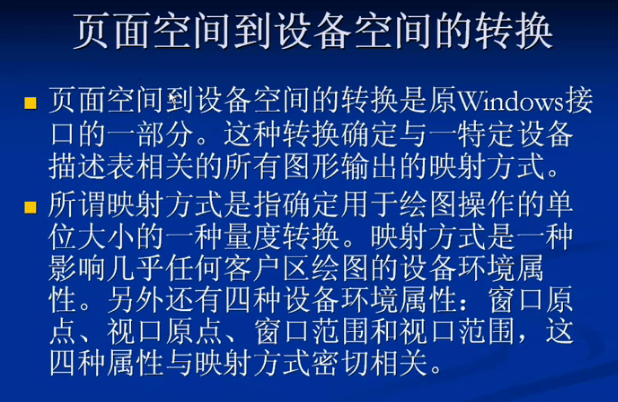


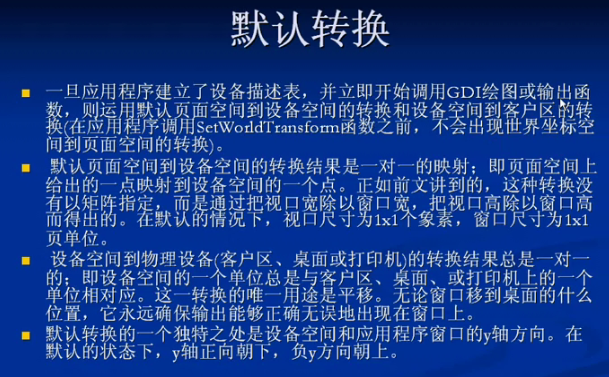

5.SetScrollSizes设置滚动条大小
第一个参数是映射模式:

6.SetMapMode可以改变映射模式
7.逻辑坐标和设备坐标转换
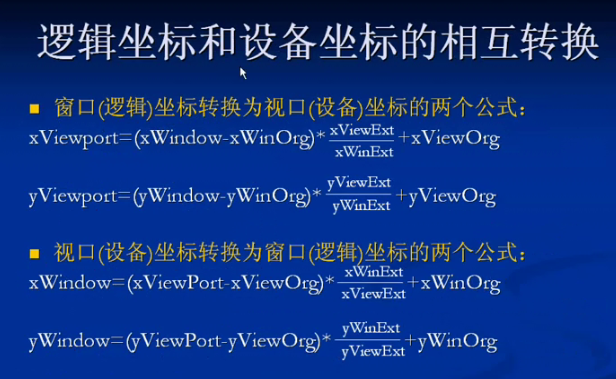

8. OnInitialUpdate是窗口创建完成之后第一个被调用的函数(在OnDraw之前),可以在这里设置滚动条大小
9.视口和窗口原点的改变
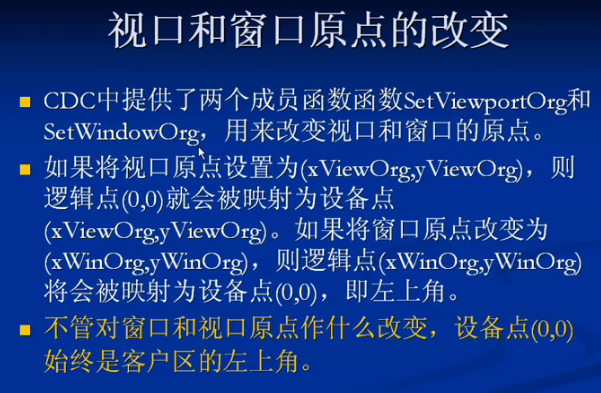
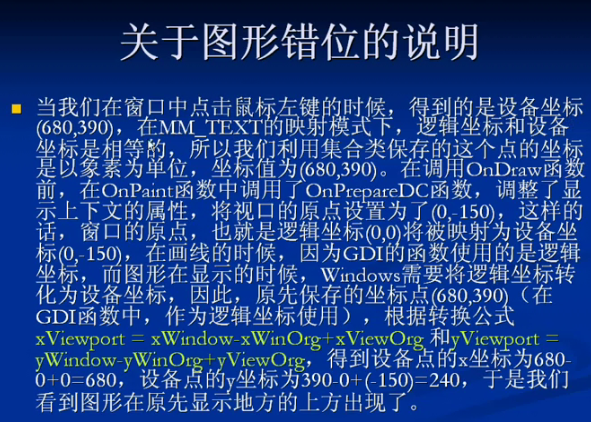


10.DPtoLP将设备点转换为逻辑点
11.LPtoDP将逻辑点转换为设备点
12.利用CMetaFileDC类保存与重现画布
13.CMetaFileDC::Create会创建一个源文件,如果参数为NULL,会创建一个内存文件
14.CMetaFileDC::Close方法会关闭DC,返回HMETAFILE(源文件句柄)对象
15.PlayMetaFile重现画布
16.DeleteMetaFile删除源文件
17.CopyMetaFile将源文件保存至文件
18.GetMetaFile(GetEnhMetaFile)从文件或取Meta File
19.CreateCompatibleBitmap 初始化一个位图与指定DC兼容
20.兼容DC也是内存DC,在窗口中不可见
21.
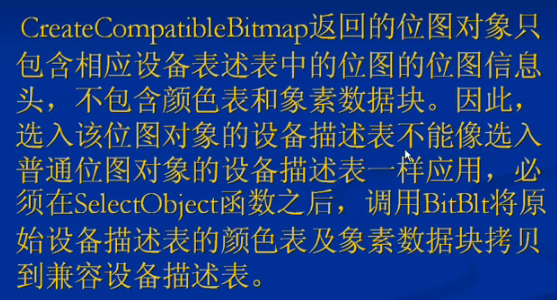
22.总结:
保存图像的三种方法:
*1.保存绘图操作步骤
*2.使用CMetaFileDC重现画布
*3.使用兼容位图,复制位图到当前DC
